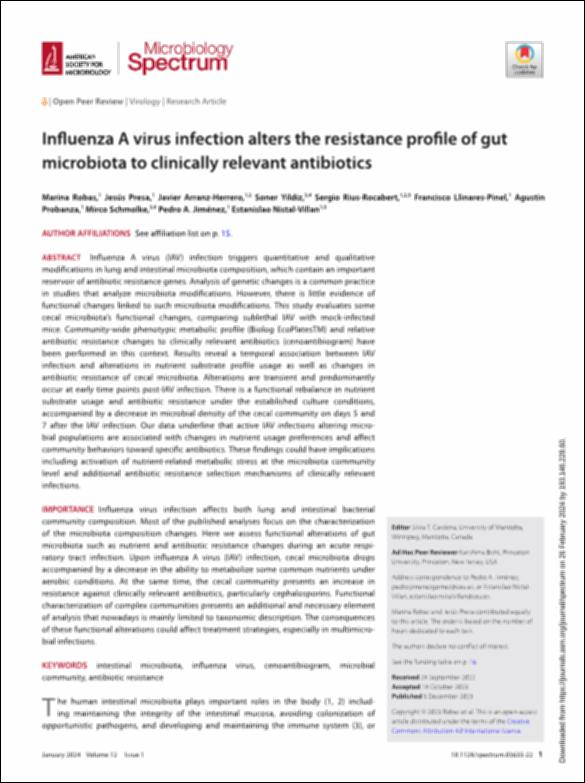Please use this identifier to cite or link to this item:
http://hdl.handle.net/10637/15527Influenza A virus infection alters the resistance profile of gut microbiota to clinically relevant antibiotics
| Title: | Influenza A virus infection alters the resistance profile of gut microbiota to clinically relevant antibiotics |
| Authors : | Robas Mora, Marina Presa, Jesús Arranz Herrero, Javier Yildiz, Soner Rius Rocabert, Sergio Llinares Pinel, Francisco Probanza Lobo, Agustín Schomolke, Pedro Nistal Villán, Estanislao |
| Keywords: | Virology; Intestinal microbiota; Influenza virus; Cenoantibiogram; Microbial community; Antibiotic resistance |
| Publisher: | American Society for Microbiology |
| Citation: | Robas M, Presa J, Arranz-Herrero J, Yildiz S, Rius-Rocabert S, Llinares-Pinel F, Probanza A, Schmolke M, Jiménez PA, Nistal-Villan E.2024.Influenza A virus infection alters the resistance profile of gut microbiota to clinically relevant antibiotics. Microbiol Spectr12:e03635-22.https://doi.org/10.1128/spectrum.03635-22 |
| Abstract: | Influenza A virus (IAV) infection triggers quantitative and qualitative modifications in lung and intestinal microbiota composition, which contain an important reservoir of antibiotic resistance genes. Analysis of genetic changes is a common practice in studies that analyze microbiota modifications. However, there is little evidence of functional changes linked to such microbiota modifications. This study evaluates some cecal microbiota’s functional changes, comparing sublethal IAV with mock-infected mice. Community-wide phenotypic metabolic profile (Biolog EcoPlatesTM) and relative antibiotic resistance changes to clinically relevant antibiotics (cenoantibiogram) have been performed in this context. Results reveal a temporal association between IAV infection and alterations in nutrient substrate profile usage as well as changes in antibiotic resistance of cecal microbiota. Alterations are transient and predominantly occur at early time points post-IAV infection. There is a functional rebalance in nutrient substrate usage and antibiotic resistance under the established culture conditions, accompanied by a decrease in microbial density of the cecal community on days 5 and 7 after the IAV infection. Our data underline that active IAV infections altering microbial populations are associated with changes in nutrient usage preferences and affectaffectaffectcommunity behaviors toward specific antibiotics. These findings could have implications including activation of nutrient-related metabolic stress at the microbiota community level and additional antibiotic resistance selection mechanisms of clinically relevant infections. Influenza virus infection affects both lung and intestinal bacterial community composition. Most of the published analyses focus on the characterization of the microbiota composition changes. Here we assess functional alterations of gut microbiota such as nutrient and antibiotic resistance changes during an acute respiratory tract infection. Upon influenza A virus (IAV) infection, cecal microbiota drops accompanied by a decrease in the ability to metabolize some common nutrients under aerobic conditions. At the same time, the cecal community presents an increase in resistance against clinically relevant antibiotics, particularly cephalosporins. Functional characterization of complex communities presents an additional and necessary element of analysis that nowadays is mainly limited to taxonomic description. The consequences of these functional alterations could affect treatment strategies, especially in multimicrobial infections. |
| URI: | http://hdl.handle.net/10637/15527 |
| Rights : | http://creativecommons.org/licenses/by-nc-nd/4.0/deed.es Open Access |
| ISSN: | 2165-0497 |
| Issue Date: | 5-Dec-2023 |
| Center : | Universidad San Pablo-CEU |
| Appears in Collections: | Facultad de Farmacia |
Items in DSpace are protected by copyright, with all rights reserved, unless otherwise indicated.


